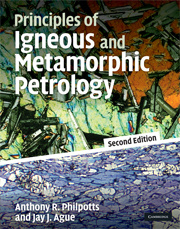Book contents
- Frontmatter
- Contents
- Preface
- Acknowledgments
- List of units
- 1 Introduction
- 2 Physical properties of magma
- 3 Intrusion of magma
- 4 Forms of igneous bodies
- 5 Cooling of igneous bodies and other diffusion processes
- 6 Classification of igneous rocks
- 7 Introduction to thermodynamics
- 8 Free energy and phase equilibria
- 9 Thermodynamics of solutions
- 10 Phase equilibria in igneous systems
- 11 Effects of volatiles on melt equilibria
- 12 Crystal growth
- 13 Isotope geochemistry related to petrology
- 14 Magmatic processes
- 15 Igneous rock associations
- 16 Metamorphism and metamorphic facies
- 17 Deformation and textures of metamorphic rocks
- 18 Graphical analysis of metamorphic mineral assemblages
- 19 Geothermometry, geobarometry, and mineral reactions among solid solutions
- 20 Mineral reactions involving H2O and CO2
- 21 Material transport during metamorphism
- 22 Pressure–temperature–time paths and heat transfer during metamorphism
- 23 Origin of rocks
- Answers to selected numerical problems
- References
- Index
11 - Effects of volatiles on melt equilibria
- Frontmatter
- Contents
- Preface
- Acknowledgments
- List of units
- 1 Introduction
- 2 Physical properties of magma
- 3 Intrusion of magma
- 4 Forms of igneous bodies
- 5 Cooling of igneous bodies and other diffusion processes
- 6 Classification of igneous rocks
- 7 Introduction to thermodynamics
- 8 Free energy and phase equilibria
- 9 Thermodynamics of solutions
- 10 Phase equilibria in igneous systems
- 11 Effects of volatiles on melt equilibria
- 12 Crystal growth
- 13 Isotope geochemistry related to petrology
- 14 Magmatic processes
- 15 Igneous rock associations
- 16 Metamorphism and metamorphic facies
- 17 Deformation and textures of metamorphic rocks
- 18 Graphical analysis of metamorphic mineral assemblages
- 19 Geothermometry, geobarometry, and mineral reactions among solid solutions
- 20 Mineral reactions involving H2O and CO2
- 21 Material transport during metamorphism
- 22 Pressure–temperature–time paths and heat transfer during metamorphism
- 23 Origin of rocks
- Answers to selected numerical problems
- References
- Index
Summary
INTRODUCTION: COMPOSITION OF VOLCANIC GASES
All magmatic components under specified conditions of temperature, total pressure, and magma composition have a definite vapor pressure, but for most components it is so small, even at the low confining pressures on the Earth's surface, that these components form only condensed phases; that is, solids and liquids. A few components, however, can have high vapor pressures, and if their concentrations are high enough, or the confining pressure low enough, they may form a separate gaseous phase. These are the components referred to as the volatile constituents of magmas. Even the normally condensed components can become volatile if pressures are extremely low (approaching a vacuum). Such pressures existed in the early solar nebula during accretion of the planets, and under these conditions differences in the vapor pressures of the common rock-forming minerals played an important role in determining what minerals could condense to form the planets.
The volatile constituents of magmas, although normally present in only small amounts, can profoundly affect liquidus temperatures, phases that crystallize, and magmatic fractionation trends. They play an important role in the generation of magmas, and as such are probably responsible for the shallow depth of the asthenosphere (Liu et al., 2006) and the Earth's unique style of tectonism (Ulmer, 2001). Heat and volatiles released from basaltic magma intruded at the base of the crust cause melting of the crustal rocks, with formation of hydrous intermediate and silicic magmas (Annen et al., 2006).
- Type
- Chapter
- Information
- Principles of Igneous and Metamorphic Petrology , pp. 243 - 267Publisher: Cambridge University PressPrint publication year: 2009



